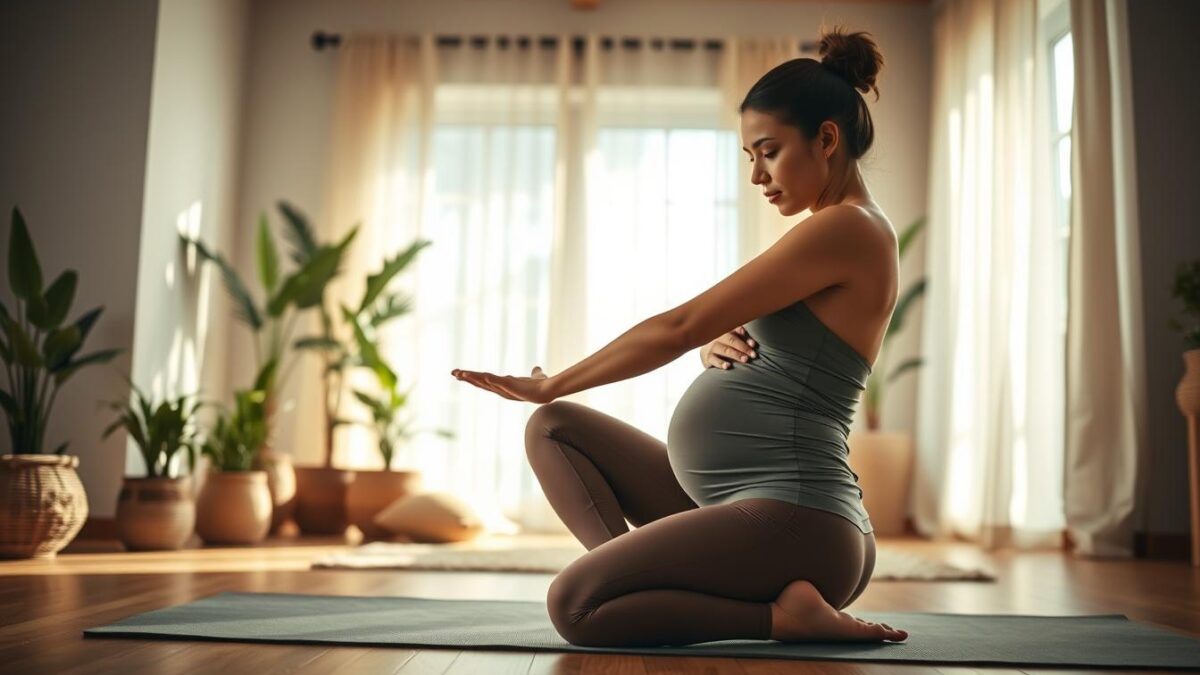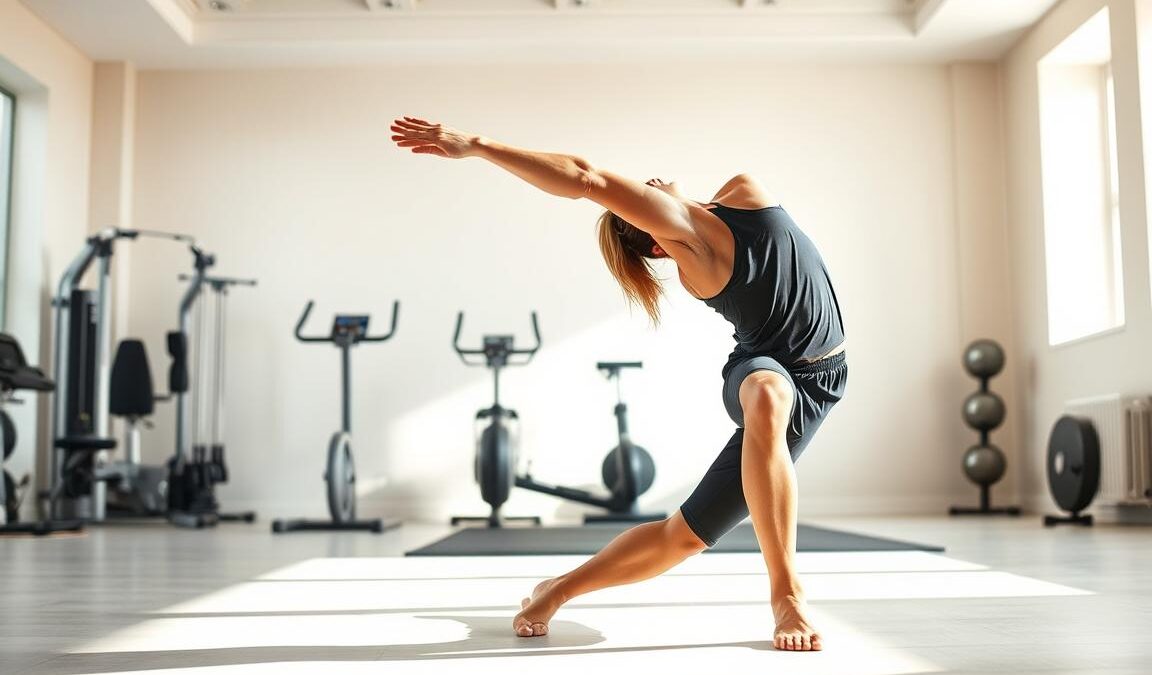
Safe Postpartum Workout Routine to Rebuild Strength
As a new mom, you might be curious about starting a safe workout routine after childbirth. Your body has changed a lot, and it’s important to exercise carefully. By doing postpartum recovery exercises, you can get stronger, feel better, and reduce stress. This is good for you and your baby.
In this article, we’ll show you key exercises for new moms. We want to help you regain your energy and strength.
Understanding Your Postpartum Body
Pregnancy changes your body in many ways. These changes can make new moms feel different, both inside and out. It’s important to understand these changes, like weak core, pelvic floor issues, and hormonal shifts.
After having a baby, your body faces new challenges. Your abdominal muscles might be weak because of pregnancy. This can make it hard to balance and move around as a new parent.
Your pelvic floor also needs care. It can weaken from the pressure of childbirth, causing problems like incontinence. Taking care of your pelvic floor is key to getting stronger again.
Hormonal changes add to the postpartum challenges. These changes can cause mood swings and tiredness, making it hard to be active. Knowing about these changes helps you set realistic goals for recovery.
Learning about postpartum recovery helps you pick the right exercises. With the right knowledge, you can set goals that fit your needs. This makes your recovery journey more successful.
When to Start Exercising After Birth
Every new mom is different when it comes to starting exercise after birth. Most can start with gentle movements around six weeks post-delivery. This is with the okay from a healthcare provider. It helps the body heal properly.
Some moms might want to start sooner. Walking is a great, safe choice for new moms. It’s a gentle way to begin. Everyone’s path to fitness is unique, based on how they gave birth, how fast they recover, and how they feel.
It’s important to listen to your body. Pay attention to how you feel during any activity. Don’t push yourself too hard too soon. Every step towards fitness is a positive step.
Benefits of Postpartum Exercise
Exercising after having a baby has many benefits. It helps strengthen your core and pelvic floor muscles, which can weaken during pregnancy. This is key for regaining stability and improving your physical function.
Working out after childbirth boosts your energy levels. As you get stronger, you might feel happier, which helps fight postpartum depression. Many moms say that staying active makes them feel accomplished and good about themselves.
Regular exercise also improves your sleep. Better sleep means clearer thinking and stronger emotions. It makes it easier to manage your weight and get back to your pre-pregnancy fitness.
In the end, exercising after childbirth helps moms feel like themselves again. When you focus on your health and fitness, you become a role model for your family.
Guidelines for Safe Exercise Postpartum
Going back to exercise after having a baby needs careful thought. Your body has changed a lot. So, it’s key to focus on safety as you start your fitness journey.
Begin with low-impact activities like walking or gentle stretching. These help your body get used to moving again without hurting. It’s important to listen to your body and make changes if needed.
Don’t skip warm-ups before any workout. They get your muscles ready, lower injury risk, and improve how well you do. Include exercises that strengthen your core and pelvic floor early on. A strong base helps with recovery and keeps you fit for the long term.
Stay away from high-impact moves at first to protect your healing body and joints. Build strength slowly, avoiding exercises that might hurt or cause discomfort. Setting realistic goals helps keep a positive attitude, making your journey more fun and doable.
Using guided resources or joining postpartum fitness classes can offer extra support. Having a community around you boosts your sense of belonging and motivation.
Take your time on this journey. Prioritizing postpartum workout safety helps with recovery and boosts your overall well-being. Remember, your health and comfort should always be your top priority as you build a lasting workout routine.
Postpartum Safe Workout Routine
Creating a workout plan after having a baby is key for new moms. Start by building strength slowly. Focus on your core and pelvic floor, and work on getting fit overall. Try to do a 20-30 minute workout, 5-6 times a week.
It’s important to listen to your body. Adjust how often you work out based on how you feel. Make sure to rest and recover well.
Key Focus Areas for New Moms
- Core Stability: Strengthening your core helps support your back and improves posture.
- Pelvic Floor Exercises: Essential for restoring function and addressing any discomfort.
- Overall Strength Training: Aimed at reinforcing muscle groups affected by pregnancy and childbirth.
Recommended Duration and Frequency
A good daily workout plan should be 20-30 minutes long. It should mix cardio, strength, and flexibility exercises. Start with 5-6 days a week, but adjust as needed.

Essential Exercises for Rebuilding Core Strength
After childbirth, your body needs special care, focusing on your core strength. Doing core exercises after having a baby is key for recovery and getting fit. These exercises help regain strength and get you ready for a healthier life.
Importance of Pelvic Floor Exercises
New moms should really focus on pelvic floor exercises. Kegels are great for these muscles, helping with bladder control and preventing prolapse. Doing these exercises daily can make you feel more comfortable and confident.
Effective Diastasis Recti Recovery Techniques
Fixing diastasis recti is important for your belly after pregnancy. Try gentle exercises like modified planks and controlled leg lifts. Deep breathing and proper alignment are also important to protect your back. These steps help heal your belly and build core strength.
Low-Impact Cardio: A Great Start
Low-impact cardio is a great way for new moms to get back into shape. It includes gentle exercises like walking after having a baby. These activities help build strength slowly and are easy on the body.
Daily walks are a great way to spend time with your baby and improve your heart health. Start with short walks and gradually increase the distance. As you get stronger, try adding exercises that make your heart beat faster but are gentle on your body.
Choosing low-impact cardio is a smart way to regain your energy and health. It’s a step towards a stronger and more active life.
Strength Training for New Moms
Strength training is key for new moms to get back in shape. Motherhood changes your body a lot. Doing strength training helps fight muscle loss and makes daily tasks easier.
Bodyweight exercises are a great start for new moms. They help build a strong base before moving to heavier workouts.
Bodyweight vs. Weighted Exercises
Start with bodyweight exercises when you begin your strength journey. They help you build a strong foundation without overdoing it. Squats, push-ups, and lunges work on important muscles and help you feel stable.
When you get more comfortable, add weights to make it harder. But always remember to focus on how you feel and do exercises safely.
- Bodyweight Exercises: Perfect for early postpartum recovery, building strength gently.
- Weighted Exercises: Add light weights as you get stronger; focus on form and comfort to avoid injury.
Always listen to your body while doing strength training. Regular workouts are good for your health. Start slow, focus on doing things right, and enjoy your fitness journey after having a baby.
Monitoring Your Body During Workouts
It’s key to watch how your body reacts during postpartum workouts. This is a big part of your recovery. Pay attention to any discomfort, unusual bleeding, or feeling really tired. These are signs you should stop exercising.
Reflecting on your workouts helps you understand how your body feels. Keeping a journal of your experiences is helpful. It lets you note any challenges and make needed changes. This makes your fitness journey safer and improves your overall health.
It’s vital to listen to your body during this time. Pay attention to any physical signals. Make sure your workout plan fits your current abilities. Allowing for changes helps you heal and feel empowered.
| Signs to Stop Exercising Postpartum | Description |
|---|---|
| Severe Pain | Intense discomfort that disrupts normal movement can be a warning to pause your workout. |
| Excessive Bleeding | Any increase in bleeding during or after exercise should prompt you to stop. |
| Extreme Fatigue | Feeling overly exhausted indicates that your body may need more rest than exertion. |
| Dizziness or Nausea | These symptoms suggest you may need to take a break and assess your condition. |
| Incontinence | Finding difficulty in maintaining bladder control necessitates cessation of activity until further assessment. |
Keeping Motivated While Exercising
Starting a postpartum workout routine can feel overwhelming. It’s key to keep your motivation up. Setting small, achievable goals helps keep a positive mindset.
Celebrate every small step. This keeps your spirits high and momentum going.
Setting Realistic Goals and Expectations
Start with goals that match your lifestyle and physical state. Setting realistic goals helps avoid frustration and burnout. Aim for consistency, not perfection.
Track your progress and enjoy the movement. As you build a routine, staying engaged becomes easier.
Incorporating Your Baby into Workouts
Exercising with your baby can be a bonding experience. Activities like stroller walking or parent-baby yoga make fitness fun. It turns workout time into a special bonding moment.
Adding your baby to workouts creates a sense of community and support. Enjoying physical activity together enriches your daily life and boosts well-being.
Rest and Recovery: Essential for Healing
Rest and recovery are not just luxuries; they are vital for your postpartum healing. After childbirth, your body needs time to mend. Adequate rest helps you regain strength and lets your muscles fully recover.
Ignoring this important aspect can slow down your progress and harm your well-being. It’s not just about taking a break. Active recovery days, like light stretching or walks, are also beneficial. They promote circulation without stressing your body too much.
Listening to your body’s signals is key. It helps you know when to push yourself and when to rest. This ensures you keep a balanced approach to fitness.
Remember, self-care is vital for both physical and mental health. Focusing on healing after exercise helps you build a lasting fitness journey. When you rest, you give your body the tools it needs to thrive.
Embrace this time of recovery. It’s a critical part of becoming a stronger, healthier mom.



